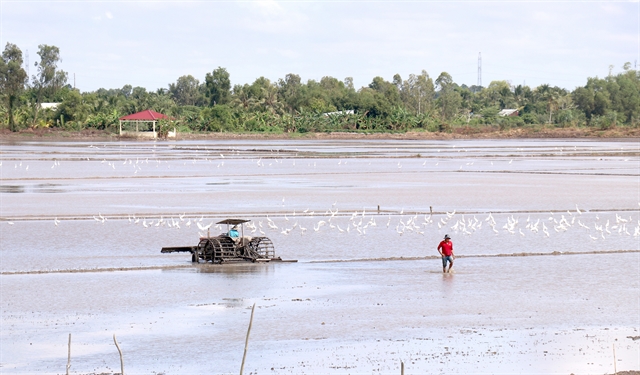 Society
Society

The Cửu Long (Mekong) Delta province of Kiên Giang, the country’s largest rice producer, aims to increase the added-value of agricultural produce by 2 – 3 per cent a year from now to 2025.

|
| Farmers prepare the soil to sow the 2021-22 winter – spring rice in Kiên Giang Province’s Châu Thành District. — VNA/VNS Photo Lê Huy Hải |
KIÊN GIANG — The Cửu Long (Mekong) Delta province of Kiên Giang, the country’s largest rice producer, aims to increase the added-value of agricultural produce by 2-3 per cent a year from now to 2025.
It also plans to use advanced farming techniques for more than 20 per cent of its produce, according to its Department of Agriculture and Rural Development.
The rate of produce cultivated under farm contracts will account for more than 30 per cent of total agricultural produce by 2025. Under the plan, the export value of farm produce will increase by 3-5 per cent a year during the period.
The province also targets increasing the average annual income per capita in rural areas to VNĐ70 million (US$3,000) in 2025, up 1.5 times against last year.
Lê Hữu Toàn, deputy director of the province's Department of Agriculture and Rural Development, said: “The province will restructure agricultural production towards sustainability, and increase quality, added value and competitiveness.”
The province aims to improve the income of rural residents, and ensure food security and defence, he said. Infrastructure and social services in rural areas will be developed on a par with urban areas.
In the 2016-20 period, Kiên Giang increased the added value of agricultural produce.
The average revenue from crop cultivation was VNĐ83.8 million ($3,600) per hectare a year, up VNĐ5.6 million against 2015, while the average revenue from aquaculture was VNĐ130 million ($5,600), up VNĐ45.5 million.
The province’s agriculture – forestry – fisheries sector achieved an average growth rate of 3.3 per cent a year from 2016 to 2020.
Under its restructuring plan during that period, the province reduced its proportion of agricultural production as part of its regional gross domestic product from 40.39 per cent in 2015 to 32.74 per cent last year.
Under the plan, rice and seafood are considered key agricultural produce. Last year, the province planted 725,863ha of rice with a total output of more than 4.5 million tonnes, with high-quality rice varieties accounting for 80 per cent of the total rice cultivating area.
More farmers of large-scale rice fields have contracts with companies to secure outlets, and use advanced techniques to increase yield and quality.
In the seafood sector, the province has effective aquaculture models for freshwater and brackish water areas. It has developed marine aquaculture with the cultivation of fish, pearl oysters and other aquatic species in floating cages in the sea.
Last year, its industrial shrimp farming area reached 5,000ha with an annual output of 31,300 tonnes.
Farmers have turned ineffective rice fields in coastal areas into shrimp-and-rice rotation cultivation in the same field for a profit of VNĐ100-130 million ($4,300-5,600) per hectare a year.
The province has 102,586ha of shrimp – rice farming areas, the largest area in the delta.
In the 2015-20 period, the province mobilised more than VNĐ26 trillion ($1.1 billion) from various sources to invest in infrastructure for agricultural production.
At the end of last year, 79 of its 116 communes had been recognised as new – style rural areas under the national new – style rural area programme.
Lâm Minh Thành, chairman of the province's People’s Committee, said that clean and organic agriculture production along with the processing industry for local produce would be developed.
Agriculture production is also adapting to climate change and more investment is being poured into infrastructure. The fishing industry will be restructured to ensure sustainable marine resources, he said. VNS




